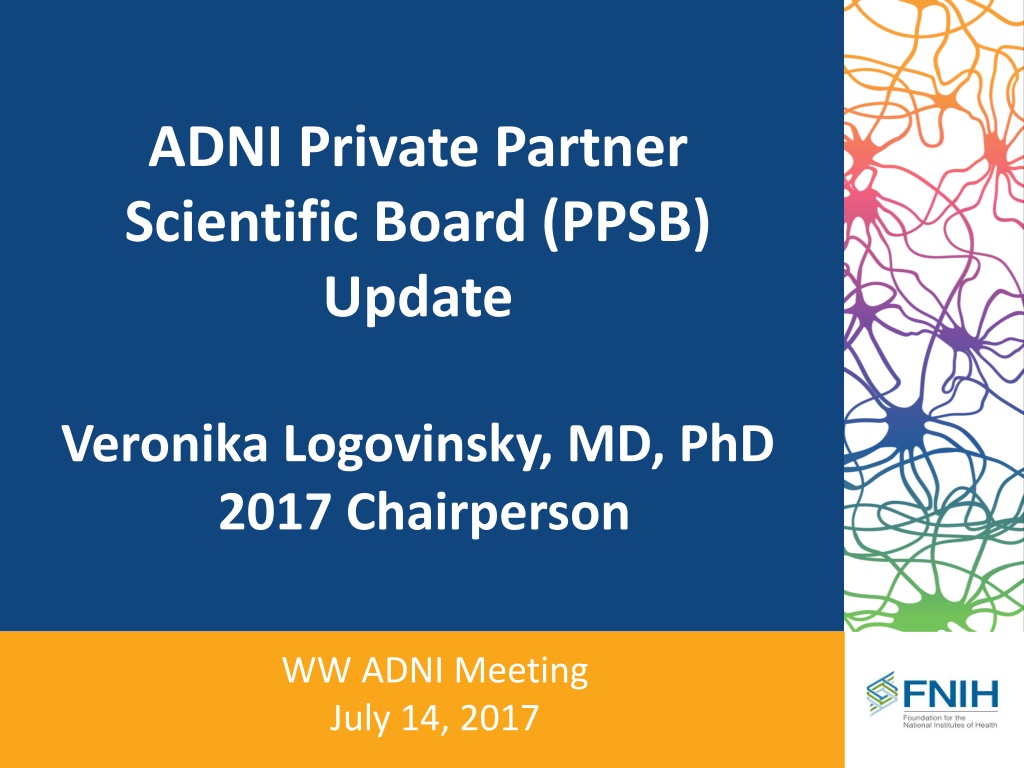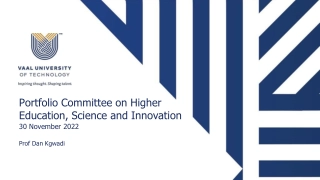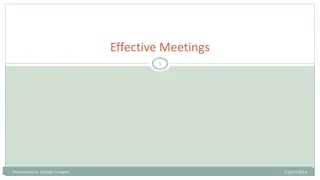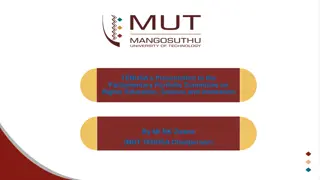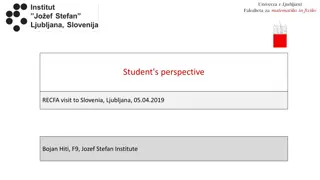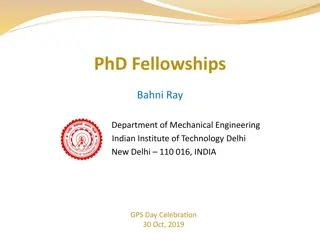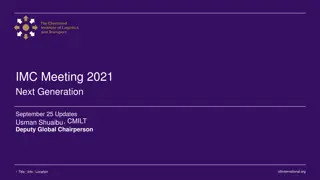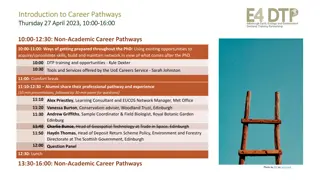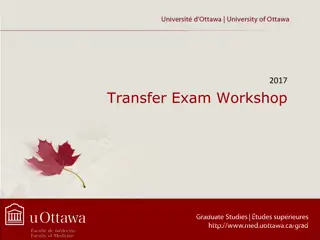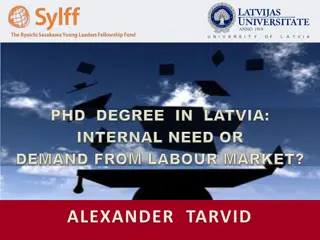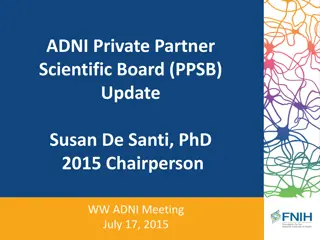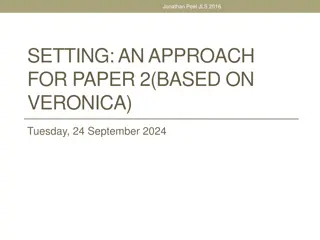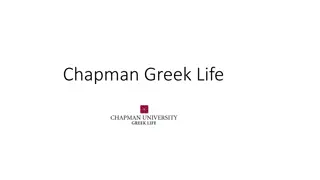Veronika Logovinsky, MD, PhD - PPSB Chairperson Update 2017
Veronika Logovinsky, MD, PhD, chaired the ADNI Private Partner Scientific Board (PPSB) meeting on July 14, 2017. The PPSB, comprising leadership and working groups, focuses on providing advice for ADNI 3 implementation and accelerating drug development. The Clinical Endpoints Working Group, led by Veronika Logovinsky, collaborates with various members to achieve its objectives.
Download Presentation

Please find below an Image/Link to download the presentation.
The content on the website is provided AS IS for your information and personal use only. It may not be sold, licensed, or shared on other websites without obtaining consent from the author. Download presentation by click this link. If you encounter any issues during the download, it is possible that the publisher has removed the file from their server.
E N D
Presentation Transcript
ADNI Private Partner Scientific Board (PPSB) Update Veronika Logovinsky, MD, PhD 2017 Chairperson WW ADNI Meeting July 14, 2017
PPSB: Leadership Chair N/A Chair-elect Veronika Logovinsky, Eisai FNIH Michael Biarnes, Scientific Project Manager* Rosa Canet-Aviles, Scientific Program Manager Dinetta Parrott, Partnership Development Officer# Julie Wolf-Rodda, Director of Development Past PPSB Chairs Robert Dean, Eli Lilly; Susan De Santi, Piramal Pharma, Inc.; Gerald Novak, Janssen; Jesse Cedarbaum, Biogen; Adam Schwarz, Eli Lilly; Johan Luthman, Eisai; Enchi Liu, Janssen AI; Mark Schmidt, J&J; Holly Soares, Abbvie; Patricia Cole, Takeda; Eric Siemers, Eli Lilly; Bill Potter; Pete Snyder * Primary project manager # Primary Partnership Development contact 2
PPSB: 2017 Key Deliverables Provide advice and input from a private partner perspective on the ADNI 3 implementation In the pre-competitive space, evaluate needs/gaps and recommend projects or analyses that could accelerate drug development PPSB working groups interface with ADNI cores on achieving working group goals and objectives Articulate & communicate PPSB needs to the ADNI leadership (via PPSB Core Liaisons and the ADNI PPSB Chair) 4
Clinical Endpoints Working Group Chair Veronika Logovinsky**, Eisai; Nandini Raghavan*, J&J (past co-chair) Alette Wessels, Lilly; Angshuman Sarkar, Novartis; Chang-Heok Soh, Roche; Enchi Liu, Janssen; Gerald Novak*, J&J; Peng Yu*, Lilly; Peter Castelluccio, Lilly; Tobias Bittner, Roche; Xin Zhao, J&J; Julie Chandler, Merck; Chad Swanson**, Eisai; Adam Schwarz*, Lilly; Kristin Kahle Wrobleski, Lilly; Michael Egan, Merck; Michael Ropacki*, Janssen; Annette Merdes*, Servier; Lyn Harper Mozley, Merck; Holly Posner**, Pfizer; Jesse Cedarbaum, Biogen; Susan De Santi*, Piramal; Bruce Albala*, Eisai; Johan Luthman, Eisai; Lu Xu, Eisai Rick Margolin*, Pfizer; Robert Brashear*, Janssen; Michael Ryan*, Novartis; Clinical Endpoints Working Group Members Jinping Wang, Eisai; *ADNI3 Due Diligence Team (past) **FCI Implementation Team (present) 6
Clinical Endpoints Working Group (CEWG) 1. Background: April, 2012 ADNI PPSB Data Mining Session: 4 PPSB member companies shared novel composite endpoints developed on the basis of ADNI data The PPSB made an action to revisit the utility of creating a WG focused on clinical endpoints 2. Rationale: ADNI provides rich data on clinical endpoints (population behavior, trajectories, significant covariates) The PPSB is well-positioned to leverage the resources of multiple companies in a pre-competitive space to develop critical new information on cognitive and functional endpoints Further, the PPSB offers a public space to develop consensus on endpoints for clinical trials and coordinated engagement with key experts in the field 7
CEWG Current Structure and Activities In its original form consisted of 4 work-streams 4 work-streams have been combined into single forum involved in the following tasks Implementation of a novel performance-based functional assessment tool, Financial Capacity Instrument-Short Form (FCI- SF) across ADNI3 sites Tracking quality of incoming FCI-SF data Finalization of two papers describing past work from Work- Stream 1 and Work-Stream 2 8
FCI-SF Training Materials Created and Utilized Extensive series of training materials created for FCI training and certification in a large, multiple site study: Kits with all testing materials for FCI-SF administration and binders with educational materials created and sent to sites prior to webinars Two videos, an instructional video for FCI administration and a mock administration video, created Two training webinars conducted on September 22 and September 26, 2016 FCI-SF instructional flyer produced for ADNI3 Investigator Meeting Portal with educational and training resources used for certification (see slide 10) Two webinars with instructional video and slides Individual accounts created on the FCI portal and distributed to all designated raters Training and certification performed using the portal 9
ADNI/UAB/Brookwood FCI Portal Portal Role in Rater Training and Certification Manages a large number of raters across many sites (120 raters at 60 sites) Houses reference and training materials Past webinars Videos with mock administrations for practice scoring Work sheets Q&A section Administers certification assessment Communicates with raters via blast emails Allows for real time tracking of rater activities and customized emails for uncertified raters at sites approaching approval 10 10
FCI-SF Certification: Rigorous Process Certification steps for raters who have attended a webinar 1. Review educational and training resources on portal 2. Review FCI-SF test kit and binder materials previously sent to your site 3. Conduct two local FCI-SF assessments at the site, and self-verify administration on the portal 4. As a training exercise, review and score 1 mock video on the web portal, and receive output and score 5. Proceed to certification section on portal and take certification quiz (passing score needed of 80%+) 6. After passing, print certificate from portal; ATRI automatically notified of certification and approval Certification steps for raters who have NOT attended a webinar 1. Review educational and training resources on portal 2. Review FCI-SF test kit and binder materials previously sent to your site 3. Review 2nd taped FCI-SF webinar dated September 26, 2016, and webinar slides, on portal 4. Conduct two local FCI-SF assessments at the site, and self-verify their administration on the portal 5. As a training exercise, review and score a mock video on the web portal, and receive output and score 6. Proceed to certification section on portal and take certification quiz (passing score needed of 80%+) 7. After passing, print certificate from portal; ATRI automatically notified of certification and approval At present 109 raters across 54 sites have been certified. 11
High Level Data Quality Surveillance Longitudinal FCI-SF data have been collected in small single-site studies Rater performance can be sub-optimal, even for well-established clinical instruments Many studies use an in-study rater quality surveillance strategy to identify and mitigate issues A recent report in a large, Phase 2b study in Early AD suggests that rater error can occur at a rate of 23-32% on MMSE, CDR, and ADAS-cog The FCI-SF is a new clinical tool, and it is being administered in a large multi-site study (ADNI3) by raters who have had no prior experience with the instrument It is not feasible to implement an intensive data quality surveillance approach, but high level quality assessments can and should be used CEWG and ATRI are currently developing approaches for such data quality surveillance 12
Biofluid Biomarker Working Group Chair Susan De Santi, Piramal Johan Luthman*, Eisai; Alvydas Mikulskis*, Biogen; Gary Tong, Lundbeck; Eskild Colding-J rgensen, Lundbeck; Enchi Liu*, Janssen; Richard Batrla-Utermann, Roche; Just Genius, AbbVie; Holly Soares*, BMS; Ian Sherriff, Araclon; James Hendrix, Alzheimer s Assoc.; Jeffrey Dage, Lilly; Jan Torleif Pedersen, Lundbeck; June Kaplow*, Eisai; Jesse Cedarbaum, Biogen; Omar Laterza, Merck; John Lawson, Fujirebio; Patricia Cole, Takeda; Kristin Wildsmith, Genentech; Robert Dean, Lilly; Lee Honigberg, Genentech; Mary Savage, Merck; Manu Vandijck, Fujirebio; Robert Umek, MSD; Tobias Bittner, Roche; Robert Dean*, Lilly: Tanja Schubert, BioClinica; Zivjena Vucetic, Fujirebio Biofluid Biomarkers Working Group Members *ADNI3 Due Diligence Team (past) Les Shaw*, UPenn 13
Biofluids Biomarker Working Group: Goals and Activities Broad group of Pharma & Diagnostics companies Several interfaces: GBSC project, CAMD CSF Project (C-Path) etc. Forum to discuss ADNI3 biofluid CSF & blood biomarkers, assays used, sample management & data collection Coordinate industry input into ADNI Biomarker Core activities in ADNI3 Align efforts within the PPSB Promote Biofluid Biomarkers best practices for diagnostic and prognostic intended uses (beyond ADNI) Forum to discuss Biofluid Biomarkers Rx & Dx industry-specific topics 14
Biofluids Biomarker Working Group: Current Activities Making the most of a scarce resource Pristine CSF and blood samples - Number of pristine aliquots? (see inventory in LONI) Process for requesting pristine samples - Application through RARC Final decision by NIA As per Dr. Hsiao letter dated Sept. 12, 2016; NIA makes ADNI CSF available to private companies developing commercial IVD tests subject to following conditions: All data must be made publicly available, become part of the ADNI database. Only previously assayed (thawed twice) CSF will be made available A transparent, fair process for prioritizing access essential. PPSB biomarker working group most appropriate and knowledgeable body to lead Subject to final NIA approval, additional RARC review is not necessary. 15
Biofluids Biomarker Working Group: Current Activities ADNI CSF available to private companies developing commercial IVD tests Previously thawed refrozen remnants of CSF aliquots from ADNI 1, Go and 2 assay analyses are available to assay development companies who were vetted as part of the ADNI 3 CSF assay due diligence process and submitted a proposal for these CSF samples. Goal: divide the ADNI CSF residual refrozen samples to assay companies in a fair and balanced manner for their assay development. Four members companies interested in receiving CSF provided proposals with power calculations for sample size requests addressing their aims CSF sample request sub-team formed Multiple formal meetings set with each assay company, CSF core, Biostats core, FNIH and PPSB to discuss proposal, power calculation, feasibility of proposal, etc. This process of sample distributions is at its final stages 16
Work flow for LOI CSF sample requests Companies provide specific aims and power calculations Final letter and protocol from LOI company; Finalization and approval of specific aims and sample size Revision of aims/power calculations (if necessary) and resubmission Sign off and formal FNIH letter to LOI companies Company meetings discuss specific aims and power calculations Les provides to Mike Donohue unblinding code for uploaded CSF data. Once unblinding is done companies to retrieve additional data Laurel Beckett randomly identifies samples of interest/company and provides the list to Les for retrieval Biomarker core prepares list of residual CSF aliquot samples (> 0.2 mL vol.)* Blinded samples pulled, Send to companies, Assays performed. Les sends to Laurel and biostats core will provide clinical data** for each visit Blinded data uploaded onto LONI website * including ADNI RID, LP date, unique id #, sample vol. **Baseline 1 dx; decliner/stable 17
Biofluids Biomarker Working Group: Current Activities Discussion of Novel CSF biomarkers for potential addition to ADNI-3 Which markers/analytes - e.g. alpha-synuclein, Neurogranin, TDP-43? Sufficient assay validation and clinical qualification data for inclusion into ADNI? Sufficient resources within ADNI3 for additional biomarkers? 18
PET Endpoints Working Group Mark Schmidt, J&J; Gregory Klein, Roche; Richard Margolin, Pfizer; Leads PET Endpoints Working Group Members Adam Schwarz, Lilly; Maria Carillo, Alzheimer s Association; Sergey Shcherbinin, Lilly; Edilio Borroni, Roche; Davis Ryman, AbbVie; Cyril Sur, Merck; Jesse Cedarbaum, Biogen; Dawn Matthews, ADMdx; Ping Chiao, Biogen; Derek Hill, IXICO Gary Tong, Lundbeck; Hartmuth Kolb, J&J; Patricia Cole, Takeda; Joyce Suhy, BioClinica; Susan De Santi, Piramal; Johan Luthman, Eisai; Vera Kiyasova, Servier; Timothy McCarthy, Pfizer; Robbie Weimer, Genentech;
PET Working Group: Goals for 2017 Work with the ADNI PET Core to support execution of the ADNI3 grant Work with the PPSB and ADNI PET Core for inclusion of additional tau PET tracers into ADNI 3 Work with the PPSB and ADNI PET Core on feasibility for collection of longitudinal early frame amyloid PET 20
Contact Information For Scientific Inquiries: For Partnership Development Inquiries: Michael Biarnes, M.S. Scientific Project Manager, Neuroscience Foundation for the NIH 301.594.2612 mbiarnes@fnih.org Dinetta Parrott Partnership Development Officer Foundation for the NIH 301.443.2103 dparrott@fnih.org Rosa Canet-Aviles, Ph.D. Scientific Program Manager, Neuroscience Foundation for the NIH 301.402.5346 rcanet-aviles@fnih.org Julie Wolf-Rodda Director of Development Foundation for the NIH 301.402.6027 jwolf-rodda@fnih.org Foundation for the National Institutes of Health 9650 Rockville Pike Bethesda, Md., 20814 www.fnih.org http://www.adni-info.org http://www.adni.loni.usc.edu
